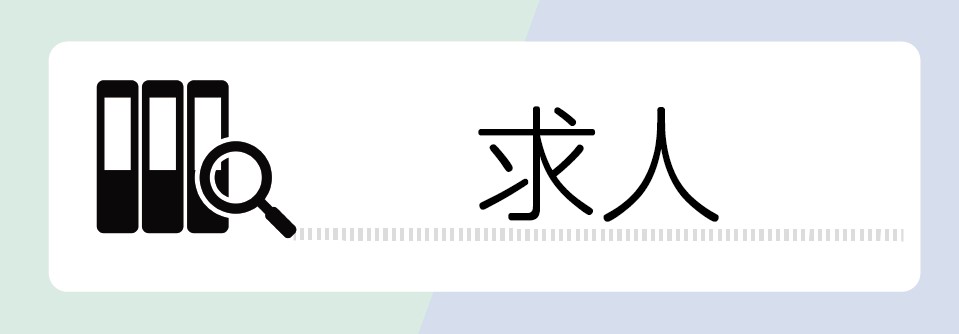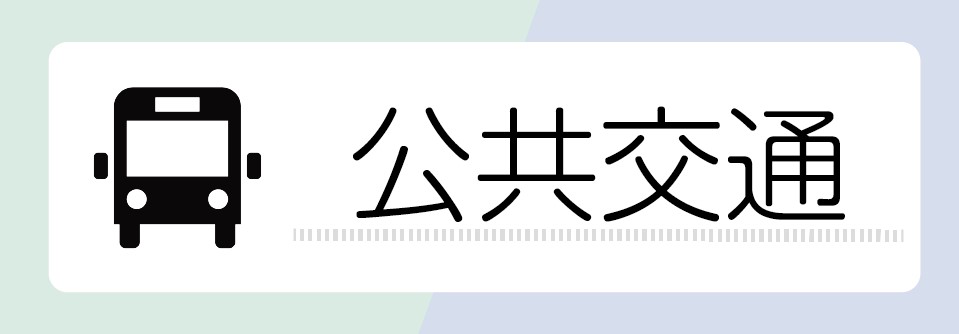Hana Taue
Hana Taue in Japan
Regions where hana taue rituals are performed
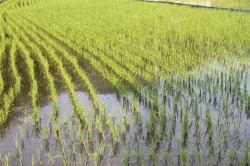 Rituals related to taue (rice planting) are held all over Japan. There are at least forty different rituals of this kind that have been designated as national cultural assets, and there would be even more if the non-designated similar rituals which are performed in surrounding areas and those which had been performed in the old days but are now no longer performed are all included.
Rituals related to taue (rice planting) are held all over Japan. There are at least forty different rituals of this kind that have been designated as national cultural assets, and there would be even more if the non-designated similar rituals which are performed in surrounding areas and those which had been performed in the old days but are now no longer performed are all included.
Generally speaking, there are various different ways to classify taue rituals. If they are classified based on the seasons during which they are performed, for example, they would be largely divided into three categories: “beginning of the year (New Year, Lunar New Year),” “rice planting season” and “autumn (harvesting season).
” The taue ritual which is performed at the “beginning of the year” is common in eastern Japan and those held in “autumn” are seen all over Japan. Because autumn is not the rice planting season, the autumn rice planting ritual comprises mostly the dances and the actions of planting rice instead of the actual rice planting itself.
On the other hand, in some rituals that are held during the “rice planting season” and that are common in western Japan, rice planting is actually included in the ritual. Many of these rituals are called otaue (temple’s or shrine’s festival or ritual), and are performed at specially prepared, so-called divine, rice fields. Rice planting rituals in which local people plow the rice fields with cows and plant rice seedlings in time with music and songs are unique to the Chugoku mountain region of western Japan, and the rice planting rituals of this kind are now only performed there.
Generally speaking, rice planting rituals performed in the Chugoku mountain region are divided into two kinds: the “hana taue type (Aki type)” in the western part of the region and the “kuyo taue type (Bingo type)” in the eastern part of the region.
In the case of hana taue festivals, the deity of the rice field, sanbai, is enshrined in the rice field. In the case of kuyo taue, on the other hand, the taue ritual is based on the belief in Mt Daisen as a deity. This is one of the main differences between these two rituals, and the difference can be seen in such things as clothing, and songs, music and dance.
There are, of course, some similarities between the two taue festivals. In areas located between these two cultural zones, there also exists a composite form of taue.
These things are thought to have come into existence over time by incorporating the good points of each ritual and the different features of each region, and making modifications in accordance with the changes that have occurred over time.
Nationwide taue related rituals [その他のファイル/260KB]
When did Hana Taue Start?
History of hana taue
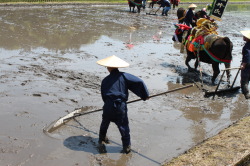 There are no accurate records showing when the hana taue first started.
There are no accurate records showing when the hana taue first started.
In Kitahiroshima-cho and the surrounding district, the music played at taue festivals since the old days has usually been called “tabayashi,” and the term “dengaku (the music and dance associated with taue) had not been used until recently. However, the term “dengaku” is often seen in narratives and picture scrolls dating back to the Heian Period (794 - 1200c.), and the descriptions of dengaku in these documents are similar to the descriptions of tabayashi.
Taking one example of rice planting in the Chugoku region, scenes of rice being planted are depicted in the “Daisen-ji Engi Emaki (picture scroll of the history of a temple)” from the Muromachi period (14c -16c). In another part of the same picture scroll, there are dengaku scenes, which seem to have been performed by professional dengaku performers called dengakushi or dengakuhoshi.
A study of rice planting songs suggests that some rice planting songs were created in medieval times (Muromachi period) from the fact that some songs from the “Taue Zoshi (copy of rice planting songbooks),” found in the Oasa area of Kitahiroshima-cho, included words which were used in those days.
In the Edo period (1603-1868), description of “otaue (rice planting by the whole local community)” is included in documents written by scholars and village headmen. Otaue is similar to the current-day hana taue. However, the former was much larger in scale and took longer than the latter - a whole day, for example.
Otaue was frequently held from the end of the Edo period to the Meiji period (1868-1912). But, during the agricultural revolution in the Meiji period and Taisho period (1912-1926), priority was placed on efficient rice production, and as a result, the otaue ritual went into decline in many parts of the country. At the time of the renaissance in local performing arts at the beginning of the Showa period (1926-1989), however, otaue was transformed into hana taue and regenerated through the efforts of various commerce and industry associations. Although they were interrupted during the war, the taue rituals were revived afterwards, and now some of them have been designated as cultural properties.
In the Showa period, “wakuue,” the planting of rice seedlings using a wooden frame to guide the direction and location of the rice planting, was frequently used. On the other hand, in hana taue, “tsunaue,” an older style of planting rice (using string laid out in straight lines in the rice field), was adopted. Tsunaue was used when otaue started to lose popularity, and therefore hana taue is thought to have started in some form which was used before the complete obsolescence of otaue.
History of dengaku and hana taue [その他のファイル/407KB]
Hana Taue and Hayashida
Term referring to “hana taue”
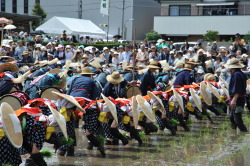 These days, the term “hana taue” is well known, but it has only been used for a short time.
These days, the term “hana taue” is well known, but it has only been used for a short time.
“Taue” generally refers to everything that is related to the planting of rice seedlings. Taue is divided into two categories: taue as in ordinary rice planting and taue as in a special event. Taue as in ordinary rice planting consists of two types: “hayaue (waseue, wasaue),” the planting of early-maturing rice, which is usually undertaken by the family; and “kumiue (moyaiue),” the planting of rice by a large number of people all working together in a cooperative way. The latter is sometimes accompanied by music.
On the other hand, taue as in a special event is called “otaue (ota, oda).” This is an event-type taue which is carried out by a large number of people. The term “otaue” was often used for rice planting in modern and contemporary times.
“Hana taue,” which is performed in the Geihoku area in which sanbai is enshrined, and “kuyo taue,” which is performed in the Bihoku area and which is based on the belief in Mt Daisen as a deity, ― both fall into the category of otaue. Both terms represent characteristics of each taue.
“Hayashida” is taue which is accompanied by music. In comparison with otaue, which is event oriented, hayashida would be taue only as in the form of ordinary rice planting. However, if viewing hayashida as just “taue which is accompanied by music,” it can be said that hayashida has both an ordinary rice planting aspect and an event aspect which would fall within both ordinary rice planting taue and event-type taue.
Rice Cultivation and Hana Taue
Hana taue season
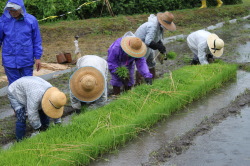 Underlying hana taue is a life based on rice cultivation. In early spring, when the snow melts, people cut down trees in the mountains (yabakori), and burn the cut down trees and the soil in the fields to make fertilizer (kugushi). Then they turn over the soil in the rice field, construct ridges between rice fields, and, at the end of spring, plant rice seedlings.
Underlying hana taue is a life based on rice cultivation. In early spring, when the snow melts, people cut down trees in the mountains (yabakori), and burn the cut down trees and the soil in the fields to make fertilizer (kugushi). Then they turn over the soil in the rice field, construct ridges between rice fields, and, at the end of spring, plant rice seedlings.
The time when hana taue was conducted was at the end of the taue season.
Before machinery was ever used in the agricultural production, many rice farmers possessed plowing and rice planting skills. Hana taue required a large rice field as a ritual site, a large number of people and cows, and a lot of money.
In the cases where a large landowner was a hana taue organizer, hana taue was performed every year. In other cases, hana taue was performed as a memorial service for cows, etc., when a veterinarian or cow and horse traders closed down their businesses or when a household which had some kind of festive event became an organizer.
Hana taue was performed no more than once a year, and because it was performed so infrequently, many participants and onlookers would come to the hana taue from neighboring areas and from far and wide.
Taue related work (Examples of work performed in the Geihoku area) [その他のファイル/41KB]
Procedure of Hana Taue
Proceeding order
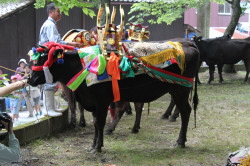 The most important part of hana taue is plowing rice fields using cows and planting rice seedlings to the accompaniment of tabayashi (dengaku) music and taue uta songs. These similar scenes are described in the records of otaue which was written in the Edo period. These days, cows adorned with decorations and michiyuki parades of people and cows walking side by side are also highlights of the hana taue ritual.
The most important part of hana taue is plowing rice fields using cows and planting rice seedlings to the accompaniment of tabayashi (dengaku) music and taue uta songs. These similar scenes are described in the records of otaue which was written in the Edo period. These days, cows adorned with decorations and michiyuki parades of people and cows walking side by side are also highlights of the hana taue ritual.
First, beautifully decorated cows are brought into the rice field (this process is called michiyuki) where the hana taue is performed, and then the shirokaki (plowing of the field) begins. When the plowing is finished, all the cows are led out of the rice field.
While the rice field is being plowed, everyone heads towards the rice field singing and miming planting the rice seedlings (michiyuki). While the field is being plowed, people take the rice seedlings from the rice nursery and bundle them up together (naetori). After the plowing is completed and the field is leveled with an eburi (a farming tool which looks like a rake and is used to level the soil), people plant rice seedlings along the lines of string which are laid out in the rice field in advance.
During hana taue, a collection of various taue uta songs, each relating to a particular part of the hana taue process, is sung. All the work involved in the hana taue process is undertaken to the accompaniment of these songs.
Order of proceedings for the people and cows in hana taue [その他のファイル/138KB]
Hana Taue and Dengaku Groups in Kitahiroshima-cho
Hana taue and hayashida is not performed in Kitahiroshima as much as it was in the past, and it is only performed in three areas of the town each year.
There are children’s dengaku groups and other associations which only perform dengaku on the stage, both of which participate in various events.
Map (Hana Taue and Dengaku Groups in Kitahiroshima-cho) [その他のファイル/153KB]
» Designated hana taue-related cultural properties in Kitahiroshima-cho
Purpose of Holding Hana Taue
Hana taue is a ritual in which Japanese people pray to the rice field deities for a good harvest. There have been various reasons for holding hana taue, some of which have changed over time.
Hana taue has always been important as a form of entertainment. In the old days, hana taue was considered to be “a special kind of rice planting and different to ordinary rice planting.” These days, however, rice production is a highly technical and mechanized industry, and as a result, hana taue has become more of a form of entertainment to enjoy the “rice planting days of old.”
Hana taue has been passed on down the generations and has undergone various different changes along the way. It can be said these changes have reflected the awareness and the understanding of the people who were responsible for hana taue in each region and in each generation.







